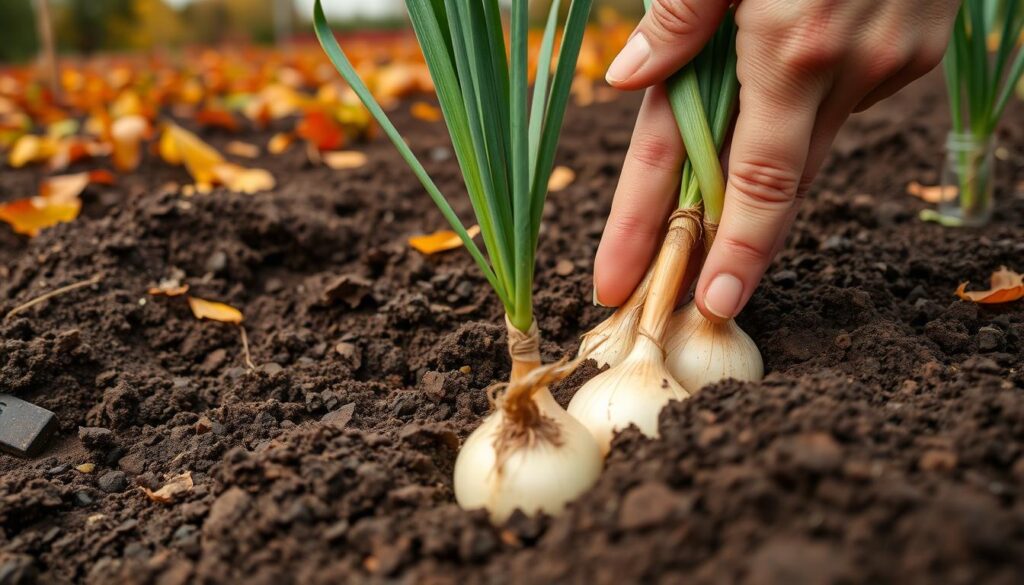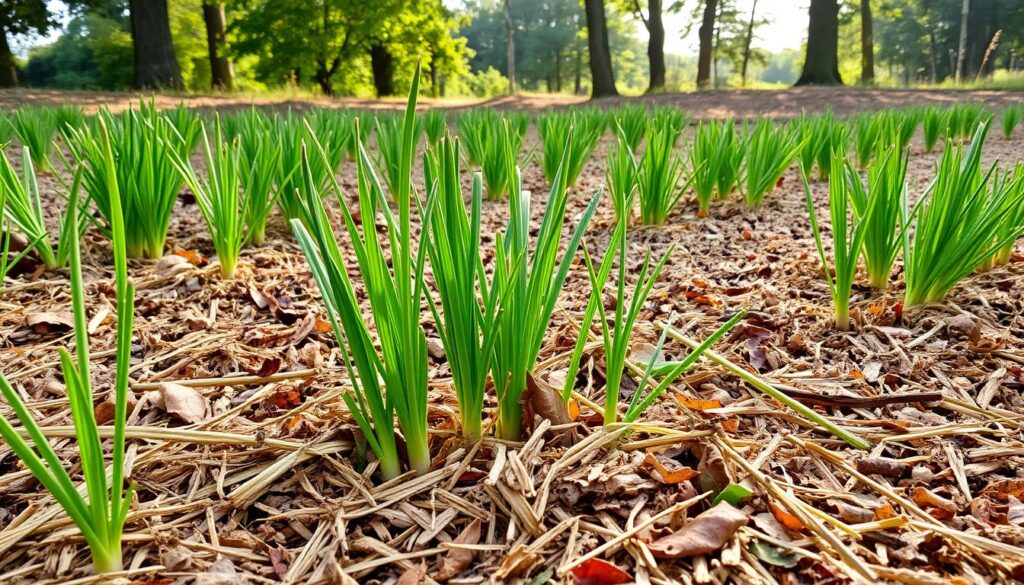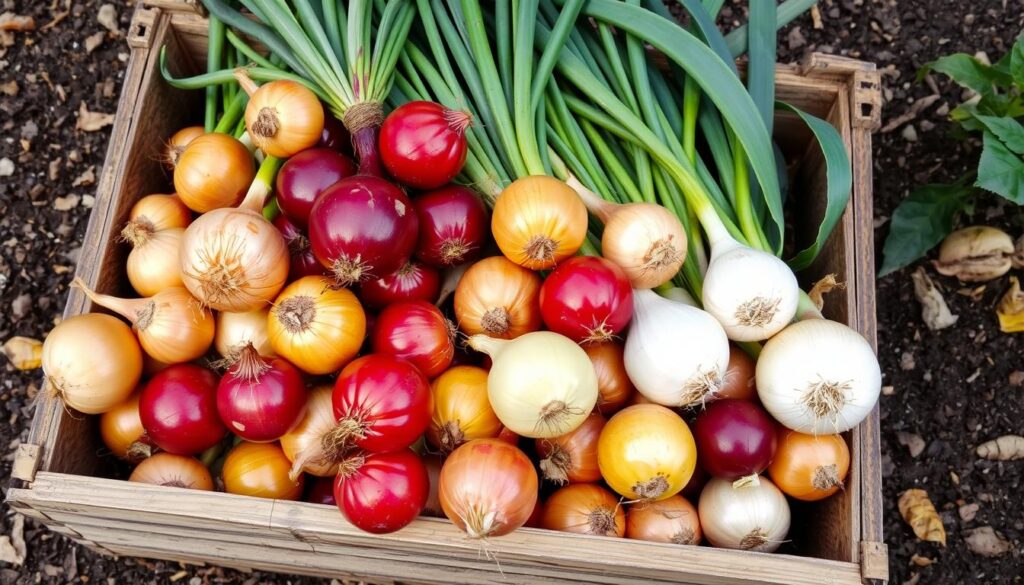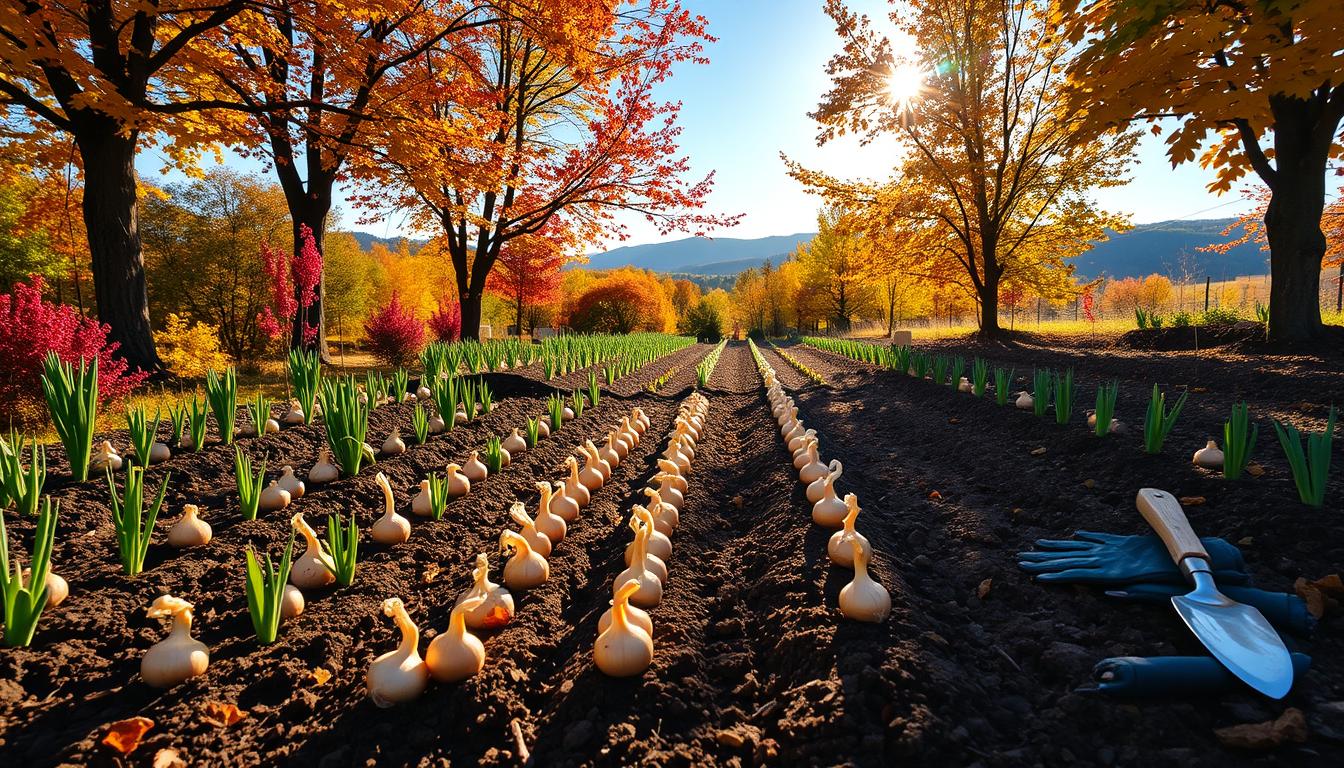I love gardening at home, and planting onions in the fall is a favorite of mine. Unlike spring planting, fall onions give me an early and bigger harvest. The cool weather helps them grow strong roots before winter.
When spring comes, my onions wake up and keep growing. They often become bigger and taste better. But, there are risks like not growing enough in the cold or bolting in spring. This can make the bulbs smaller and not last as long.
In this article, I’ll share my best tips for growing onions in the fall. We’ll cover planting, choosing the right variety, and caring for them through winter. Whether you’re new to gardening or have experience, these tips will help you grow great onions in the fall.
Planting Onions in Fall: An Alternative Approach
Onion bulb formation is a fascinating process. It’s triggered by daylight length, not plant size. Spring planting gives onions time to grow and mature before bulbing starts.
Late summer planting doesn’t offer the best conditions for onion growth. Planting in the fall is an alternative. This way, onions can grow without bulbing, ready for spring harvest.
Understanding Bulb Formation and Daylight
Onion varieties need different daylight lengths for best bulb formation. Short day onions start bulbing with 12 hours of daylight, ideal for the south. Long day onions need 14 hours and do well in the north. Midday onions tolerate 12 to 14 hours.
Planting onions in the fall means shorter daylight. This lets them grow roots without bulbing too early.
Overwintering Onions: Risks and Rewards
Overwintering onions can be risky but rewarding. If they survive winter, they might grow extra-large in spring. But, there are risks: they might not survive winter, or bolt, leading to smaller bulbs and shorter storage.
Despite these risks, overwintering onions can be a good strategy. They get a strong start in the fall, ready for spring growth.
“Fall-planted onions according to the USDA can begin growing as soon as the soil thaws in the spring, giving them a head start for the growing season.”
Growing Onions in the Fall: Key Considerations
Fall is a great time to plant onions as the weather cools down. It’s important to pick the right time and temperature. Also, preparing the soil and planting depth are key.
Ideal Planting Time and Temperature
Onions do best in cool weather. Plant them in late summer or early fall when it’s not too cold. They need 4 to 6 weeks of warm weather before it gets cold.
Soil Preparation and Planting Depth
Soil preparation is vital for growing onions in the fall. Choose a spot that drains well and slopes slightly. Till the soil to loosen it and remove rocks or debris. Add compost or aged manure to make the soil richer.
Plant onions in trenches that are 2 inches deep and a few inches wide. Make sure the pointed end is up. Space them 4 to 6 inches apart for bigger bulbs.

“Onions dislike sitting in water, so ensuring proper drainage is key for a bountiful harvest.”
By following these tips for onion planting time, fall onion planting temperature, and soil preparation, you’ll have a successful cool weather onion planting. You’ll also enjoy a rich onion planting seasons.
Caring for Fall-Planted Onions
As autumn brings cooler temperatures, it’s key to care for your fall-planted onions. They need protection from frost and extreme cold. This care is vital for their growth and a good harvest in spring.
Mulching and Protecting from Frost
After planting, cover the trench with 4 inches of mulch like straw, leaves, or sawdust. This mulch keeps the onion bulbs warm and safe from frost. When the onions start growing, add more straw or shredded leaves to protect them.
Mulching is very important in areas with lots of freeze-thaw cycles. It keeps the soil temperature steady, preventing the roots from being pushed out of the ground.
In very cold places, use low tunnels or row covers for extra protection. This simple setup can help your onions make it through winter and grow well in spring.
By mulching and protecting your onions, you’ll get a big harvest of tasty onions in summer.

Growing Onions in the Fall: Variety Selection
Choosing the right onion variety for your fall garden is key. Red onions are sweet but don’t last long. Yellow onions, on the other hand, are hardy and store well. Each variety brings its own flavor and benefits to your kitchen.
Red Onions: Sweet but Short-Lived
Red onions are loved for their sweet taste. They’re great in salads and sandwiches. But, they don’t keep well and should be eaten quickly.
Pairing red onions with longer-storing varieties like yellow or white onions is a good idea. This way, you’ll have a steady supply of onions.
White Onions: Versatile and Longer-Lasting
White onions are a good middle ground in terms of sweetness. They’re versatile and keep longer than red onions. They’re perfect for sautéing and pickling.
White onions are a favorite among gardeners and cooks. They offer a balance of flavor and longevity.
Yellow Onions: Hardy and Long-Storing
Yellow onions are the most durable. They’re not as sweet as reds but store for months. They’re great for cooking and keep well.
Yellow onions are a must-have for any kitchen. They’re reliable and add depth to many dishes.

When planning your fall onion garden, think about each variety’s strengths and weaknesses. A mix of red, white, and yellow onions will give you a diverse harvest. This way, you’ll have flavorful onions all year round.
Conclusion
Growing onions in the fall can be very rewarding. It’s a great alternative to planting in the spring. By understanding the right factors, like daylength and soil, gardeners can get a bigger harvest sooner.
Fall onions need a bit more care, but it’s worth it. The effort leads to enjoying fresh, tasty onions for longer. This makes fall planting a valuable investment.
If you’re new to gardening or onions, try growing them in the fall. With the right knowledge and patience, you’ll enjoy the unique flavors and benefits of fall onions.
FAQ
Q: Why should I consider planting onions in the fall?
A: Planting onions in the fall can give you an earlier and bigger harvest. Fall onions get a head start on growing before winter. When spring comes, they grow even more, often making bigger bulbs.
Q: What are the risks of overwintering onions?
A: Overwintering onions can be risky. They might not grow enough before winter or bolt in spring. This can make the bulbs smaller and shorter-lived.
Q: When is the best time to plant onions in the fall?
A: Plant onion sets when it’s cool but not cold. This is usually late summer or early fall. Wait until the temperature stays above 28°F (-2°C) after planting.
Q: How should I prepare the soil for fall-planted onions?
A: Choose a spot with well-draining soil on a slope. Onions don’t like wet feet. Till the soil to loosen it and remove rocks or debris. Add compost or manure to the planting holes.
Q: How do I care for fall-planted onions over the winter?
A: After planting, cover the trench with 4 inches of straw or leaves. As the onions grow, add more straw or shredded leaves. This keeps them warm, weeds away, and moist.
Q: Which onion varieties are best for fall planting?
A: Yellow onions are great for fall, lasting up to 6 months when stored right. White onions are also good, lasting longer than reds. They’re perfect for cooking, pickling, and fresh use.






